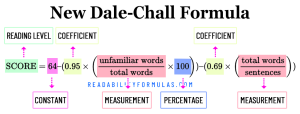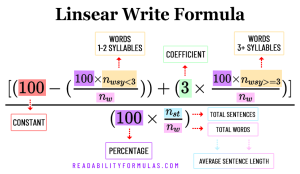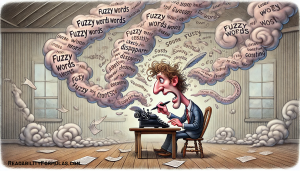 The Powers-Sumner-Kearl Formulas are a set of “updated” tools to evaluate the readability of text. Linguists R.D. Powers, W.A. Sumner, and B.E. Kearl recalibrated four popular readability formulas to see if they could improve outcomes.
The Powers-Sumner-Kearl Formulas are a set of “updated” tools to evaluate the readability of text. Linguists R.D. Powers, W.A. Sumner, and B.E. Kearl recalibrated four popular readability formulas to see if they could improve outcomes.
The formulas include:
- The Flesch Reading Ease Formula
- The Dale-Chall Readability Formula
- The Farr-Jenkins-Paterson Simplification of the Flesch Reading Ease Formula (this formula counts the percentage of monosyllables instead of the Flesch syllable count.)
- The Gunning Fog Index
To validate their results, the linguists used updated editions of McCall-Crabbs Reading Lessons to fine-tune each formula to reflect modern language and reading comprehension. Their research was published in an article titled “A Recalculation of Four Adult Readability Formulas” (Journal of Educational Psychology, 1958).
|
Gunning Fog (Recalculated) where ASL = Average Sentence Length | \(n_{wsy>=3}\) = the number of words with 3-syllables or more. |
Gunning Fog Original Formula:
- Calculation: This formula uses the average sentence length and the number of complex words (polysyllables).
- Formula: 0.4 x (average sentence length + percentage of complex words).
- Interpretation: Higher scores indicate more complex texts. Scores above 12 are often seen in professional documents.
Recalculated Formula:
- Formula: 3.0680 + (0.0877 x sentence length) + (0.0984 x % polysyllables).
- Adjustment: The definition of “complex words” was updated, including technical jargon and longer words more common in specific professional and academic fields.
- Precision and Effectiveness: The recalculated formula is more adept at evaluating academic and professional texts, reflecting the increased complexity and specialization of language in these areas.
| Flesch Reading Ease (Recalculated) $$ (0.0778 \times (ASL) + (4.55 \times \frac{n_{sy}}{n_{w}}) – 2.2029$$ |
Original Formula:
- Formula: 206.835 – (1.015 x ASL) – (84.6 x ASW).
- Calculation: It was based on the average sentence length (ASL) and the average number of syllables per word (ASW).
- Interpretation: Higher scores indicate easier readability. Typically, a score between 60-70 is common for adult readers.
Recalculated Formula:
- Formula: -2.2029 + (0.0778 x sentence length) + (0.0455 x syllables per 100 words).
- Adjustment: The recalibration updated sentence length and syllable count to reflect contemporary language, which tends to have shorter sentences and simpler word choices.
- Precision and Effectiveness: The recalculated Flesch formula statistically explained about 40% of the variation in difficulty of the McCall-Crabbs tests.
| Farr-Jenkins-Paterson’s Flesch’s Reading Ease (Recalculated) $$ 8.4335 + (0.0923 \times ASL) – \frac{n_{wsy=1}}{n_{w}})$$ |
Original Formula:
- Formula: $$-31.517 – (1.015 \times ASL) + (1.599 \times \frac{n_{wsy=1}}{n_{w}})$$
- Calculation: This was a simplified version of the Flesch formula, using the percentage of monosyllabic words instead of syllable count.
- Formula: Similar to the Flesch formula but replaces the syllable count with monosyllable count.
Recalculated Formula:
- Formula: 8.4335 + (0.0923 x sentence length) – (0.0648 x % monosyllables)
- Adjustment: The recalibration reflected changes in the use of monosyllables.
- Precision and Effectiveness: This recalculated formula was about equal in predictive power to the Gunning formula, but weaker than the Flesch and Dale-Chall formulas.
| Dale-Chall (Recalculated) $$0.1155 \times (100 \frac{n_{wd}}{n_{w}}) + (0.0596 \times ASL) + 3.2672 $$ |
Original Formula:
- Formula: 3.6365 + (0.0496 x sentence length) + (0.1579 x % of non-Dale words).
- Calculation: This formula uses sentence length and the percentage of difficult words.
- Interpretation: Higher scores indicate more challenging texts. Scores around 7-8 are typical for texts suited for adults.
Recalculated Formula:
- Formula: 3.2672 + (0.0596 x sentence length) + (0.1155 x % non-Dale words)
- Adjustment: The difficult words list was updated to include modern vocabulary and jargon, adjusting the difficulty percentage to contemporary language use.
- Precision and Effectiveness: The recalculated formula had a higher predictive power, explaining almost 51% of the variation in difficulty of the McCall-Crabbs tests.
To assess real-world results of their recalculations, the linguists applied both the original and recalculated formulas. They found inconsistent scores between both. They concluded that readability formulas yield rough estimates, not precise grade level results. Claiming that one formula is better than another is also statistically tricky.
ReadabilityFormulas.com uses the original formulas because they are reliable and predictable on modern language. Recalculated formulas (sometimes called “simplified formulas”)—based off of updated McCall-Crabbs Reading Lessons—can sacrifice precision and accuracy, according to the linguists.
Scott, Brian. “The Powers-Sumner-Kearl Simplified Readability Formulas.” ReadabilityFormulas.com, 11 Jan. 2025, https://readabilityformulas.com/the-powers-sumner-kearl-readability-formula/.





